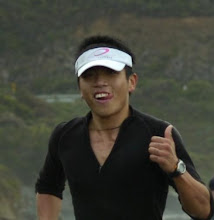Friday, August 04, 2006
#13: Light configuration
With the huge growth in the AR and endurance mountain biking sectors, night-time mountain biking strategy has advanced to the point where it having two lights - one on the handlebar and another on the helmet - is now almost essential for staying competitive.
Having the more powerful light on your helmet is best for handling the really technical trails, while the less powerful light can act as a backup ato the handlebars. On roads or open, easy off-road terrain, the helmet light can be switched off to conserve battery power. One shortcoming of having a top dollar, super-bright LED or HID unit on one's head, particularly in AR, is that when reading maps, the glare created can cause a swift loss of night vision. To combat this, installation of a pilot light can be beneficial. The Princeton Tec Pilot is just such a unit that is purpose-made for auxillary, low-level lighting for reading maps, documents, and other close-in work. The main light is turned off when stationary map work needs to be done, and then turned on again when movement resumes.
While having the more powerful light on the handlebars may be the way to go for the team navigator, the ideal setup is to have two powerful units, with the light levels on the helmet unit adjustable to the point where at its lowest setting, it can comfortably allow accurate map reading without creating blinding glare, and allows a degree of map-ground comparison to be done on the move, in easy terrain.
As far as possible, the team navigator should strive to maintain his night vision, and guard against becoming blinded by him/herself or team mates. The economic and careful usage of powerful lighting is crucial as night navigation on the bikes rates as one of the most demanding aspects of the sport. Other team mates should act as spotters, observing the lay of the land and the surroundings for crucial navigational features with the help of powerful helmet lights. The navigator, on the other hand, has to keep a constant watch on the input of his team, sensory data, cyclo-computer & altimeter readings, and map-ground comparisons... but he/she must still be prepared to use his/her own lights at full power to spot features and confirm ground, if required.
With the huge growth in the AR and endurance mountain biking sectors, night-time mountain biking strategy has advanced to the point where it having two lights - one on the handlebar and another on the helmet - is now almost essential for staying competitive.
Having the more powerful light on your helmet is best for handling the really technical trails, while the less powerful light can act as a backup ato the handlebars. On roads or open, easy off-road terrain, the helmet light can be switched off to conserve battery power. One shortcoming of having a top dollar, super-bright LED or HID unit on one's head, particularly in AR, is that when reading maps, the glare created can cause a swift loss of night vision. To combat this, installation of a pilot light can be beneficial. The Princeton Tec Pilot is just such a unit that is purpose-made for auxillary, low-level lighting for reading maps, documents, and other close-in work. The main light is turned off when stationary map work needs to be done, and then turned on again when movement resumes.
While having the more powerful light on the handlebars may be the way to go for the team navigator, the ideal setup is to have two powerful units, with the light levels on the helmet unit adjustable to the point where at its lowest setting, it can comfortably allow accurate map reading without creating blinding glare, and allows a degree of map-ground comparison to be done on the move, in easy terrain.
As far as possible, the team navigator should strive to maintain his night vision, and guard against becoming blinded by him/herself or team mates. The economic and careful usage of powerful lighting is crucial as night navigation on the bikes rates as one of the most demanding aspects of the sport. Other team mates should act as spotters, observing the lay of the land and the surroundings for crucial navigational features with the help of powerful helmet lights. The navigator, on the other hand, has to keep a constant watch on the input of his team, sensory data, cyclo-computer & altimeter readings, and map-ground comparisons... but he/she must still be prepared to use his/her own lights at full power to spot features and confirm ground, if required.

